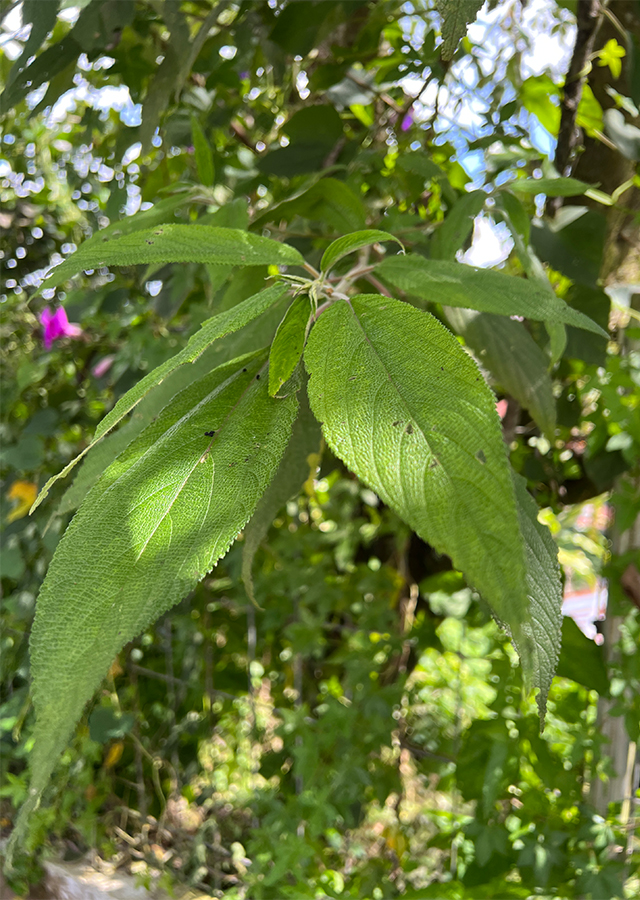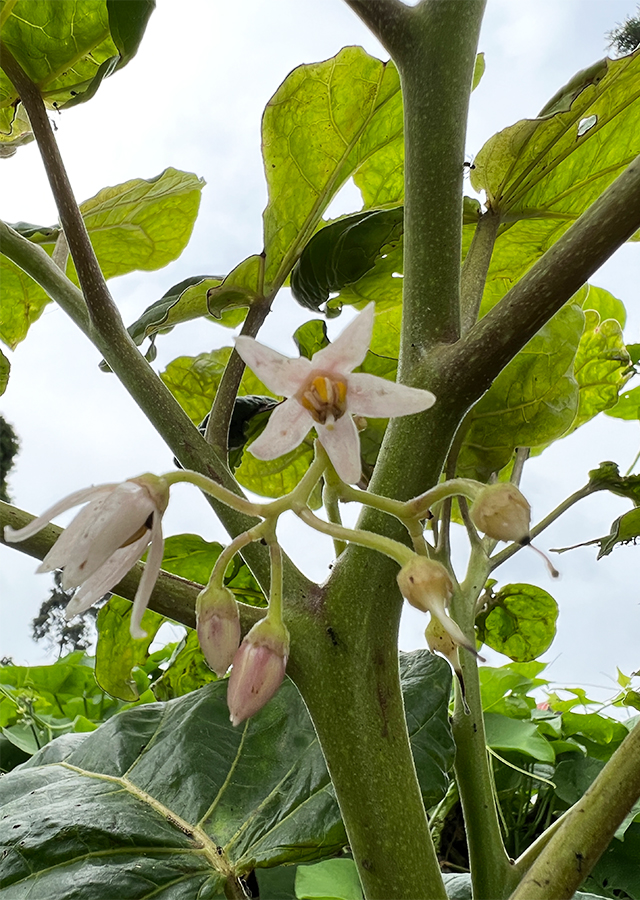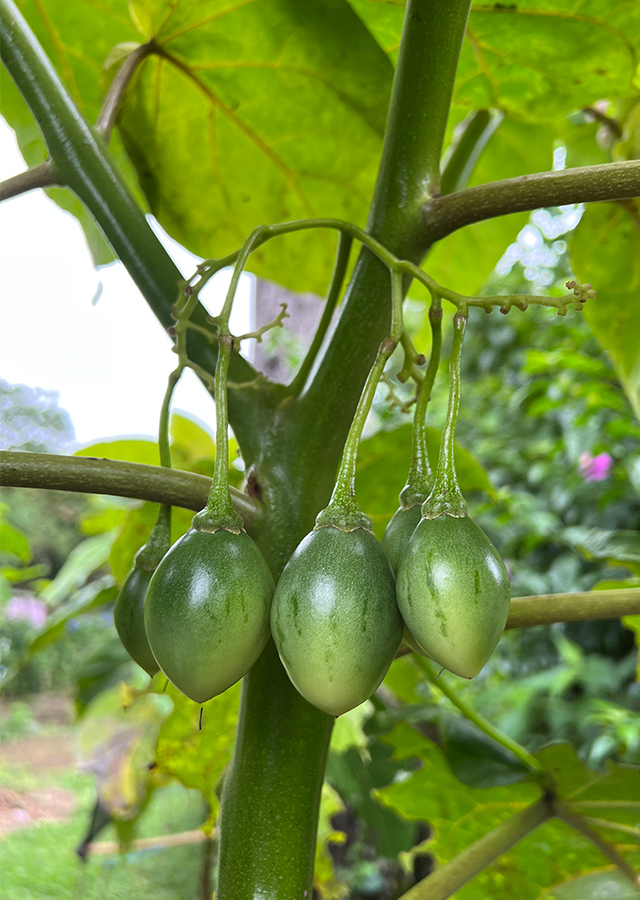Traditional Herbs from Solanum betaceum
treating_anemia
- Prepare tamarillo fruit that is ripe.
- Take the flesh of the fruit then blend it and add a little boiled water.
- Strain then drink.
- Taman eggplant juice can treat anemia.
medicine_ache_throat
- Take tamarillo leaves.
- Warm them and wrap them around your neck as a medicine for a sore throat.
What is Solanum betaceum Looks like??



Parts of Solanum betaceum that could be used
- Leaves
- Fruits
Solanum betaceum Distribution
Dutch eggplant is native to southern Bolivia and adjacent northwestern Argentina, cultivated throughout the Andes in subtropical climates, altitudes of 1000 -� 3000 m and introduced to Mexico, Central America and the West Indies. This plant is also cultivated in Spain, Portugal, France, England, Netherlands, Italy, Canary Islands, Ghana, Ethiopia, Zaire, Uganda, Tanzania, Zimbabwe, South Africa, India, Sri Lanka, Bhutan, Sumatra, Java, New Guinea, New Caledonia , New Zealand, Australia and the United States. Dutch eggplant fruit is used by eating it as fresh fruit, as a cooking spice, as a vegetable and as a drink. This eggplant can be eaten fresh, boiled, made into pickles, and so on. The fruit contains about 150 IU of vitamin A per 100g, 25mg of vitamin C, rich in vitamin E and iron but low in carbohydrates. Dutch eggplant is useful for speeding up and helping metabolism, such as increasing immunity and body freshness. Apart from that, tamarillo has benefits as an antioxidant because it contains vitamin A, vitamin E, vitamin C, vitamin B6, carotenoids, flavonoids and fiber. Apart from that, this plant is also believed to be used as a traditional medicine in several countries to cure several diseases. Dutch eggplant leaves have also been used as a natural dye.Agroecology of Solanum betaceum
Plants grow best at low elevations in the subtropics and moderate to high elevations in the tropics, where they can thrive at altitudes up to 2,800 m above sea level. They grow best in areas where annual daytime temperatures are in the range of 16 - 22 °C, but can tolerate 10 - 30 °C. They can be killed at temperatures of -2 °C or lower. They prefer an average annual rainfall in the range of 2,000 - 2,600 mm, but tolerate 600 - 4,000 mm. Plants may not be sensitive to day length. Succeeds in a sunny position in well-drained soil. Prefers light, slightly acidic, fertile soil. Prefers pH in the range of 6.3 - 7, tolerates 5.8 - 7.5. Doesn't like dryness. Plants are very susceptible to wind damage. Plants have shallow root systems and do not like to be hoeed over the surface, they are best mulched.
Morphology of Solanum betaceum
- Densely puberulent stem with unbranched glandular and eglandular hairs. Sympodial unit (3-) 4-foliate.
- Leaves simple, blade 7-40 x 6-35 cm, ca. 1-1.5 times longer than broad, chartreuse, ovate, slightly pubescent adaxially with unbranched hairs, denser on veins, densely pubescent below; cm; margin overall; acuminate apex; petiole 3-25 cm, densely pubescent.
- Flowers,\u00a0inflorescence 2.5-15 cm, (unbranched or) branched, with 10-50 flowers, all flowers perfect, axial medium to densely pubescent; pedicel 1.5-9 cm; rachis 2-8 cm; pedicel 10-20 mm, fruit 15-50 mm, spaced 3-10 mm, articulated above the base, leaving a pedicellar remnant 1-3 mm long, elliptical to ovoid flower buds, obtuse to tapering at apex. Flowers with calyx radius 3-5 mm, lobes 1-2 x 2-. 3 mm, delta, obtuse to truncated, shoot at tip, fleshy, sparsely to densely pubescent. Corolla 2-2.5 cm diameter, radius 10-15 mm, stellate, subcoriaceous to fleshy, pinkish white, tube 2-3 mm, lobes 7-12 x 2.5-4 mm at base, narrowly triangular , pointed at apex , abaxially and adaxially glabrous, margins tomentose. Anther anther 5-6 x 2-2.5 mm, lanceolate, connivent, pale yellow, pores directed adaxially and distally; ligament 4.5-5 x 1-2 mm, narrowly triangular, slightly shorter at the base than the theca at the apex, equal to or slightly shorter than them at the base, absent at the adaxial, bright lemon yellow. bald ovaries; style 5-6 x 0.5-1 mm., protruding 1-2.5 mm beyond stamens, cylindrical, glabrous; stigma truncated.
- Fruit 4-10 x 3-5 cm, ellipsoidal or ovoid, blunt or pointed at apex, yellow to orange, red, or purple, often with darker longitudinal stripes, glabrous; aggregate of existing stone cells.
- Seeds 3-4 x 3.5-4 mm, flat, densely pubescent.
Cultivation of Solanum betaceum
Propagated generatively using seeds, and vegetatively using stem cuttings. Seeds usually germinate within 4 weeks at a temperature of 15 �C, within 2 weeks at a temperature of 25 �C. When they are large enough plant the seedlings into individual pots and when the plants are large enough they can be planted out into the field. Stem cuttings use green wood.
Solanum betaceum, more details :
Chemical Content of Solanum betaceumCarotenoids, flavonoids, terpenoids, steroids, saponins, alkaloids and tannins.
Benefits of Solanum betaceum
The leaves are used to treat inflammation of the liver, as a medicine for sore throats. The juice is used to treat anemia and tonsillitis. The pulp, after being cooked in hot coals, is used as a poultice for inflamed tonsils.
Simplisia of Solanum betaceum
Another Facts for Solanum betaceum :
Synonym of Solanum betaceumCyphomandra betacea (Cav.) Sendtn., Cyphomandra crassifolia Kuntze, Cyphomandra procera Wawra
Habitus of Solanum betaceum
Bush. Annual shrub or small tree, 2 - 7 m high
Habitat of Solanum betaceum
- Riverside", "Forest", "Land
No comments:
Post a Comment